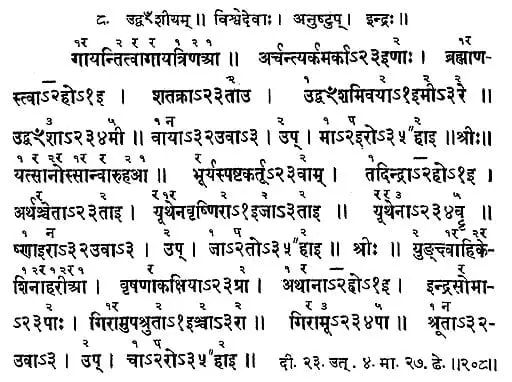The Sama Veda is one of the four Vedas, ancient Indian scriptures that are considered the oldest and most sacred texts of Hinduism. The timelines are speculative when it is composed hence we will not discuss this, and was primarily used during Vedic sacrifices and rituals. The Sama Veda is named after the Saman, a type of musical chant that was used during Vedic ceremonies. In this article, we will explore the importance of the Sama Veda in ancient Indian culture.
Significance of Sama Veda in Ancient Indian Culture
The Sama Veda, like other Vedas, is essential to the Hindu religion as it contains hymns and mantras that are used in worship, meditation, and other spiritual practices. It is the oldest book of Indian music and is regarded as the source of Indian classical music. The Sama Veda has three main parts: the Arcika, the Kauthuma, and the Ranaayaniya. Each part consists of various hymns, mantras, and chants that are intoned in a specific manner, accompanied by specific instruments.
In ancient India, the Sama Veda was an integral part of Vedic sacrifices and rituals. The Samans, which are musical chants from the Sama Veda, were sung by priests during these ceremonies to invoke the gods and goddesses. These chants were believed to have a powerful effect on the universe and were used to bring blessings and good fortune. The Sama Veda was also used to train priests and musicians in the art of Vedic chanting and music.
The Sama Veda played a crucial role in the development of Indian classical music. It is believed that the melodies and rhythms of the Samans were the basis for Indian classical music. The Sama Veda also introduced the concept of raga, which is a melodic framework that forms the basis for Indian classical music. The use of specific ragas during Vedic ceremonies was believed to have a profound effect on the human mind and body.
The Sama Veda is also significant in the study of Indian history and culture. It sheds light on the social, religious, and cultural practices of ancient India, and offers insights into the beliefs and values of the Vedic period. The hymns and mantras in the Sama Veda are a testament to the rich cultural heritage of India and provide a glimpse into the spiritual and philosophical traditions that have shaped Indian society for centuries.
In conclusion, the Sama Veda is an ancient Indian scripture that holds immense significance in the Hindu religion and Indian culture. Its hymns, mantras, and musical chants have been used for centuries in worship, meditation, and Vedic ceremonies, and have contributed to the development of Indian classical music. The Sama Veda is a testament to the rich cultural heritage of India and provides valuable insights into the spiritual and philosophical traditions of the Vedic period.
The Sama Veda is a priceless legacy of ancient India that has stood the test of time and continues to inspire and enrich people’s lives today. Its profound teachings and powerful mantras are a reminder of the timeless wisdom and enduring legacy of India’s spiritual and philosophical traditions. As we explore the Sama Veda and other ancient Indian scriptures, we gain a deeper appreciation of the beauty and complexity of India’s culture and heritage.
Image credit
Puranastudy, CC BY-SA 4.0, via Wikimedia Commons
